Physical Address
304 North Cardinal St.
Dorchester Center, MA 02124
Starting on day 17, vessels begin to arise in the splanchnic mesoderm of the yolk sac wall from aggregations of cells called hemangioblasts . From these aggregates, two cell lineages arise: primitive hematopoietic progenitor cells and endothelial precursor cells . Vasculogenesis (de novo blood vessel formation) commences in the splanchnic mesoderm of the embryonic disc and continues later in the paraxial mesoderm. In the embryonic disc, endothelial cell precursors differentiate into endothelial cells and organize into networks of small vessels that coalesce, grow, and invade other tissues to form the primary embryonic vasculature. This primitive vasculature is expanded and remodeled by angiogenesis (budding and sprouting of existing blood vessels). Hematopoiesis begins in the yolk sac extraembryonic mesoderm. It is later shifted to the liver, where the embryonic hematopoietic cells are joined by a source of definitive hematopoietic stem cells (HSCs) arising from intraembryonic splanchnic mesoderm of the dorsal aorta-gonad-mesonephros (AGM) region, the vitelline and umbilical arteries, and most likely the placenta. Definitive HSCs are programmed from hemogenic endothelium, colonize the liver where they are expanded, and later relocate to the bone marrow and other lymphatic organs.
As body folding carries the developing primitive heart tube into the ventral thorax during the fourth week, the paired dorsal aortae attached to the cranial ends of the tubes are pulled ventrally to form a pair of dorsoventral loops, the first aortic arch arteries . During the fourth and fifth weeks, additional pairs of aortic arch arteries develop in craniocaudal succession, connecting the aortic sac at the distal end of the outflow tract to the dorsal aortae. This aortic arch artery system is subsequently remodeled to form the system of great arteries in the upper thorax and neck.
The paired dorsal aortae remain separate in the region of the aortic arch arteries but eventually fuse below the level of the fourth thoracic segment to form a single median dorsal aorta. The dorsal aorta develops three sets of branches: (1) a series of ventral branches, which supply the gut and gut derivatives; (2) lateral branches, which supply retroperitoneal structures such as the suprarenal glands, kidneys, and gonads; and (3) dorsolateral intersegmental branches called intersegmental arteries , which penetrate between the somite derivatives and give rise to part of the vasculature of the head, neck, body wall, limbs, and vertebral column. The ventral branches supplying the gastrointestinal tract are derived from remnants of a network of vitelline arteries , which develop in the yolk sac and vitelline duct and anastomose with the paired dorsal aortae. The paired dorsal aortae become connected to the umbilical arteries that develop in the connecting stalk and carry blood to the placenta. Hematopoietic cells may also arise in these arteries.
The primitive venous system consists of three major components, all of which are at first bilaterally symmetrical: the cardinal system , which drains the head, neck, body wall, and limbs; the vitelline veins , which initially drain the yolk sac; and the umbilical veins , which develop in the connecting stalk and carry oxygenated blood from the placenta to the embryo. All three systems initially drain into both sinus horns, but all three undergo extensive modification during development as the systemic venous return is shifted to the right atrium.
The cardinal system initially consists of paired anterior (cranial) and posterior (caudal) cardinal veins , which meet to form short common cardinal veins draining into the right and left sinus horns. However, the posterior cardinals are supplemented and later replaced by two subsidiary venous systems—the subcardinal and supracardinal systems, which grow caudally from the base of the posterior cardinals in the medial dorsal body wall. All three of these cardinal systems, along with a small region of the right vitelline vein, contribute to the inferior caval vein and its major branches. The supracardinals also form the azygos and hemiazygos systems draining the thoracic body wall. The vitelline venous system gives rise to the liver sinusoids and to the portal system, which carries venous blood from the gastrointestinal tract to the liver. Within the substance of the liver, the vitelline system also forms the ductus venosus , a channel shunting blood from the umbilical vein directly to the inferior caval vein during gestation.
All three venous systems undergo extensive modification during development. In the cardinal and vitelline systems, the longitudinal veins on the left side of the body tend to regress, whereas those on the right side persist and give rise to the great veins. Thus, a bilateral system that drains into both sinus horns becomes a right-sided system that drains into the right atrium. In contrast, the right umbilical vein disappears and the left umbilical vein persists. However, the left umbilical vein loses its original connection to the left sinus horn and secondarily empties into the ductus venosus within the developing liver.
A dramatic and rapid change in the pattern of circulation occurs at birth as the newborn begins to breathe, the pulmonary vasculature expands, and circulation from the placenta to the fetus stops. Much of the development described in this chapter is focused on the problem of producing a circulation that will effectively distribute the oxygenated blood arriving from the placenta via the umbilical vein to the tissues of the embryo and fetus, yet will be able to convert rapidly at birth to the adult pattern of circulation required by the air-breathing infant.
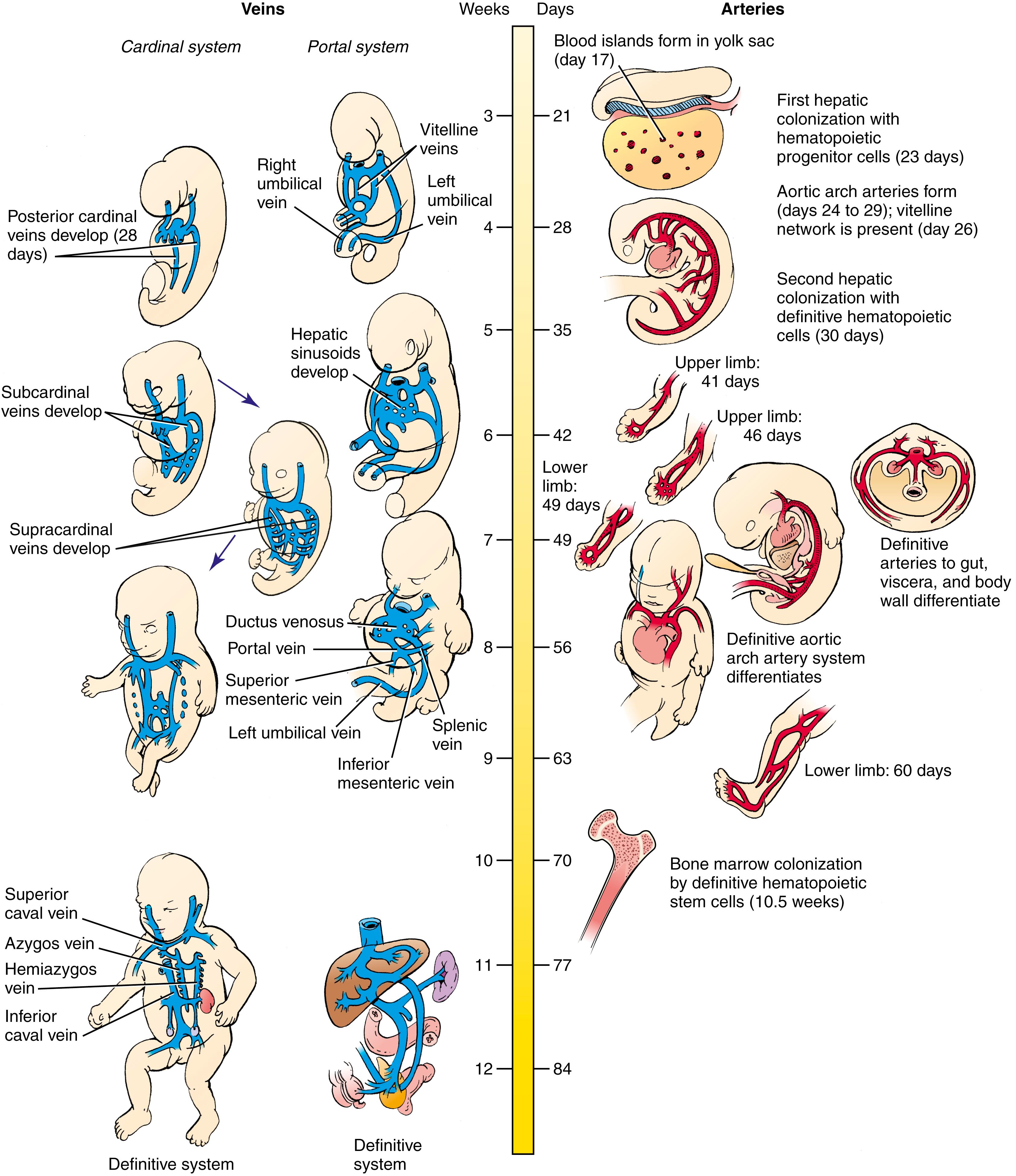
While examining a 14-year-old girl with a history of severe recurrent epistaxis (nosebleeds), an otolaryngologist—ear, nose, and throat (or ENT) specialist—notes several small dilated blood vessels on the mucosa of the nasal passages and mouth. The girl’s nosebleeds started at age 11. Recently they have become more frequent and now occur two or three times a week. The bleeding has been severe enough to cause mild anemia despite treatment with iron.
In addition to nosebleeds, the patient has significant dyspnea (shortness of breath) during exercise that is out of proportion to her degree of anemia. She also has increased heart rate and subtle clubbing of the fingers. A pulse oximeter reading shows a blood oxygen saturation of 88%. The ENT makes a presumptive diagnosis of hereditary hemorrhagic telangiectasia (HHT) , also known as Osler-Weber-Rendu disease .
The girl is referred for an air-contrast echocardiogram that shows air bubbles passing from the right side of the heart to the left, indicating a pulmonary arterial-venous shunt. A computed tomography (CT) angiogram verifies the presence of a right-sided pulmonary arterial-venous malformation measuring 7 mm in diameter. Interventional radiology is consulted, and the shunt is corrected using coil embolization (inserting a small coil to clot off the vessel). Following the procedure, the girl’s oxygen saturation increases to normal, and her exercise tolerance gradually improves. Genetic testing reveals an inactivating mutation in the ENDOGLIN gene.
HHT is an autosomal dominant condition characterized by abnormal connections between arteries and veins without intervening capillaries. When small, these abnormalities are called telangiectases and occur on the mucosal surfaces of the nose, mouth, and gastrointestinal tract, as well as on the fingers. These thin-walled lesions are near the surface and bleed easily. Larger telangiectases, or arterial-venous malformations (AVMs), can occur in the lungs, liver, or brain. Besides the morbidity associated with shunting of blood, a variety of other life-threatening complications are associated with AVMs, including stroke, abscess, and bleeding in the brain. HHT is caused by mutations in the genes encoding either the Tgfβ-binding protein endoglin or one type of Tgfβ receptor. Both of these proteins are involved in cell signaling during the development of vascular endothelial cells.
![]()
Animations are available online at StudentConsult .
Hematopoietic cells and endothelial cells are among the first and earliest cell types to differentiate into a functional phenotype in the embryo. In humans, the earliest evidence for blood and blood vessel formation is seen in the extraembryonic splanchnic mesoderm of the yolk sac at about day 17 in the form of clusters of hemangioblast cells developing adjacent to the endoderm ( Fig. 13.1 ). In mice, the earliest marker for these cell clusters is vascular endothelial growth factor receptor-2 (Vegfr2 or Flk1), also known as KDR in humans. These clusters arise from a subset of brachyury-positive cells within the primitive streak that migrate into the yolk sac. Several cell lineages arise from within these clusters of hemangioblasts, including hematopoietic cell progenitors and endothelial precursor cells (EPCs) . Endothelial cells will later surround aggregates of blood cells, forming what are often referred to as blood islands (see Fig. 13.1 ). Blood cells that form in the yolk sac blood islands are primarily primitive erythrocytes . Megakaryocytes and macrophages also form in the yolk sac wall, but the precise location of their precursor is not known. Some of the yolk sac endothelial cells arise from hemangioblasts , but most differentiate from proliferating EPCs. The differentiating endothelial cells organize into small capillary vessels through a process called vasculogenesis (described in the following section). These small capillaries lengthen and interconnect, establishing an initial primary vascular network. By the end of the third week, this network completely vascularizes the yolk sac, connecting stalk, and chorionic villi.
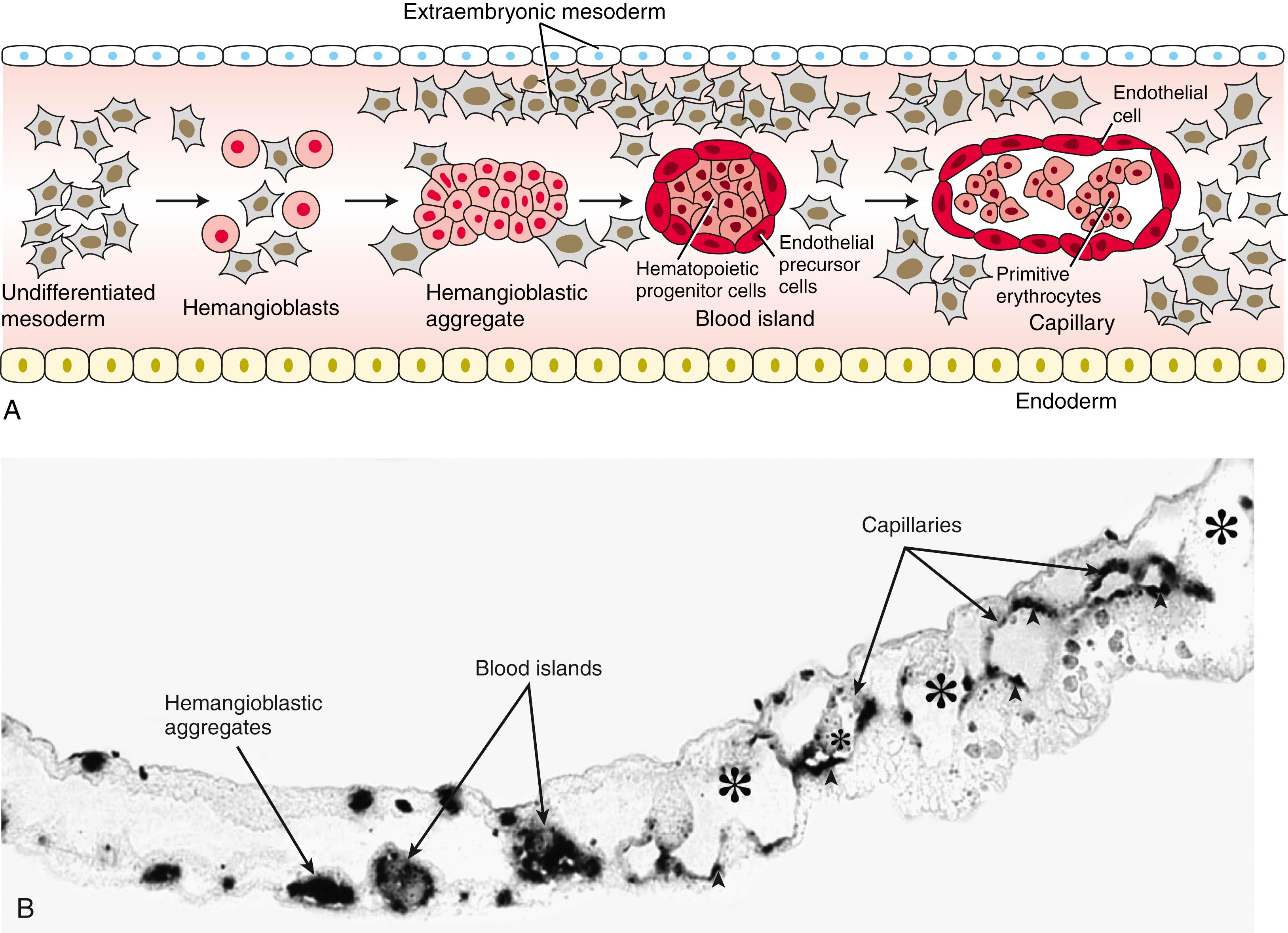
The yolk sac is the first supplier of blood cells to the embryonic circulation. The cells supplied are predominantly nucleated erythrocytes containing embryonic hemoglobin (primitive erythrocytes). By day 60, the yolk sac no longer serves as an erythropoietic organ. Rather, the task of supplying erythrocytes and other lineages of mature blood cells to the circulation is transferred to intraembryonic organs, including the liver, spleen, thymus, and bone marrow. With the onset of the functional circulatory system, these organs are seeded with hematopoietic progenitors and definitive hematopoietic stem cells (HSCs) generated in the extraembryonic and/or intraembryonic mesoderm. The first organ to be colonized is the liver. This organ remains the main hematopoietic organ of the embryo and fetus until initiation of bone marrow hematopoiesis near parturition (birth). Colonization of the liver primordia by hematopoietic cells occurs in at least two waves, the first beginning at about day 23 and containing primitive hematopoietic cells and progenitors, and the second beginning about day 30 and containing the definitive HSCs ( Fig. 13.2 ). These hematopoietic cells arise from at least two different sources (discussed in the following “In the Research Lab” entitled “Second Source of Hematopoietic Cells” and “Intraembryonic Hematopoietic cells, a Source of Adult Bone Marrow Hematopoietic Stem Cells”). The shift from generating primitive nucleated erythroblasts to enucleated erythrocytes synthesizing fetal hemoglobin ( definitive erythrocytes ) occurs by 5 weeks of gestation. This shift occurs at the time when the liver is colonized with HSCs, cells that have the potential to generate all the hematopoietic cell lineages of the adult including erythroid, myeloid, and lymphoid cells. HSCs colonize the bone marrow and contribute blood cells as early as 10½ weeks, but the bulk of the hematopoietic burden is still carried by the liver until birth. Around birth, HSCs begin generating erythrocytes that synthesize the adult forms of hemoglobin. Thus, the extraembryonic, primitive hematopoietic cells serve mainly to provide an early, but necessary, blood supply for the developing embryo until the intraembryonic hematopoietic organs containing HSCs can assume the task.
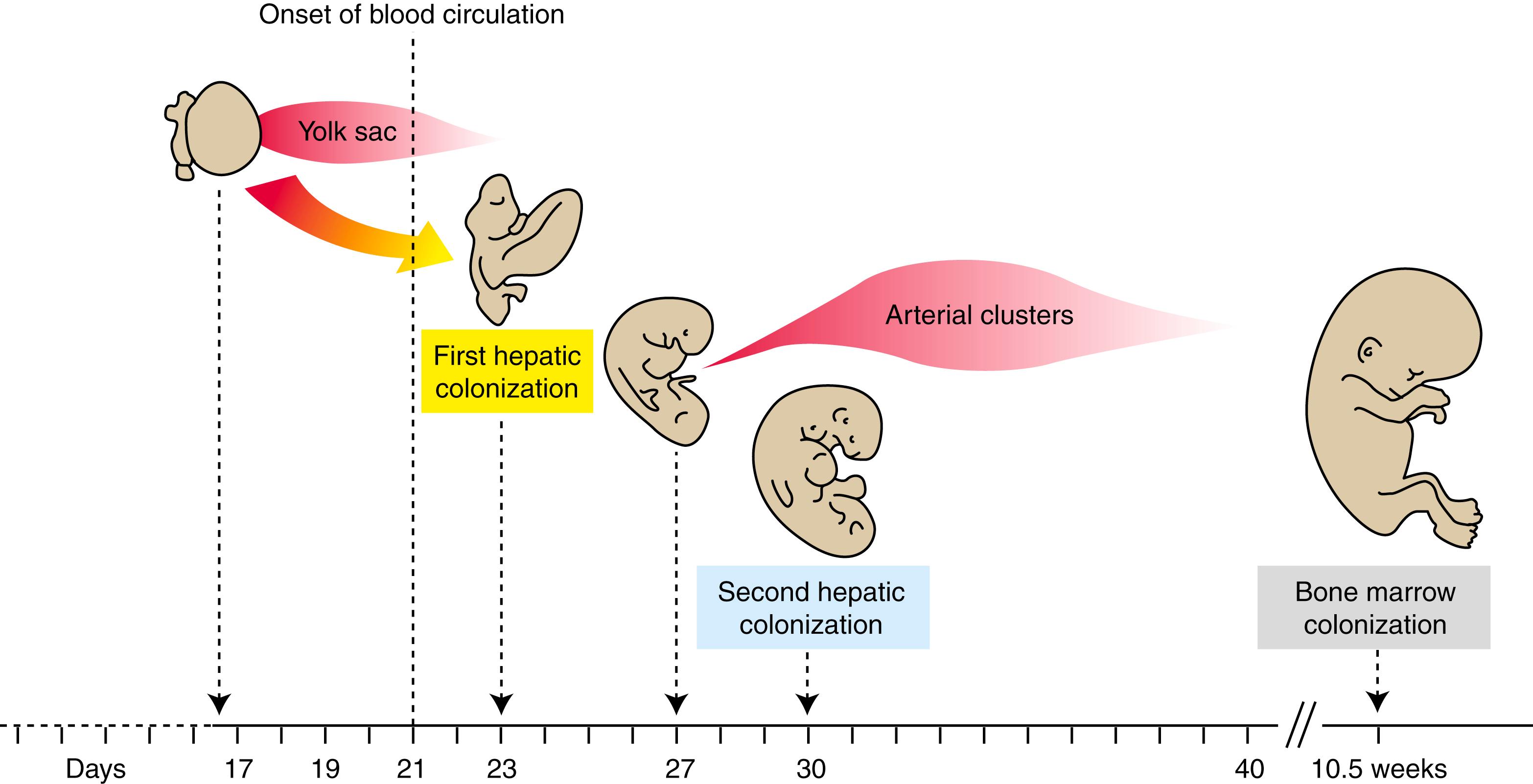
On day 18, blood vessels begin to develop in the intraembryonic splanchnic mesoderm. Unlike blood vessel formation in the extraembryonic mesoderm, blood vessel formation within intraembryonic mesoderm, with the exception of the AGM region (covered in the preceding “In the Research Lab” entitled “Second Source of Hematopoietic Cells” and “Intraembryonic Hematopoietic Cells, a Source of Adult Bone Marrow Hematopoietic Stem Cells”), is not coupled with hematopoiesis. Inducing substances secreted by the underlying endoderm cause some cells of the splanchnic mesoderm to differentiate into EPCs (or angioblasts ) that develop into
Although hematopoietic cells colonizing the developing liver initially arise from the yolk sac mesoderm, hematopoietic cells with greater potential and longevity eventually colonize the fetal liver from a separate intraembryonic source. Evidence for this second source of hematopoietic cells came from the use of quail-chick transplantation chimeras (technique covered in Chapter 5 ). In a remarkable experiment, the entire body of a 2-day embryonic chick was removed from the blastoderm, leaving just the yolk sac, and replaced with the entire body of a quail embryo. When examined after a couple of days of incubation, all blood lineages in the chimera were of chicken yolk sac origin, with quail cells providing the stromal (connective tissue) cells. However, within 5 days of grafting, a mixture of quail- and chick-derived blood cells was found circulating within the embryo, and eventually all blood cells were quail derived. Thus, this experiment showed clearly that (1) the yolk sac gives rise to transient embryonic hematopoietic cells; and (2) cells generated in the embryo body eventually replaced these cells, producing the long-lived definitive hematopoietic system. Consequently, for the first time it was shown that by closely following yolk sac hematopoiesis, there had to be a potent second source, an intraembryonic source of hematopoietic cells.
Microscopic analysis of bird, amphibian, mouse, and human embryos at equivalent developmental times identified densely packed clusters of hematopoietic cells adhering to the ventral endothelium of the dorsal aorta in the aorta-gonad-mesonephros (AGM) region and to the endothelium of the vitelline and umbilical arteries. The appearance of the hematopoietic clusters corresponds with the onset of the second wave of hematopoiesis. In humans, hematopoietic clusters appear within the aorta of the AGM region at 27 days of development as small groups of two or three cells, but by day 35, they increase to thousands of cells that extend into vessels adjacent to the umbilical cord region. These cells express transcription factors and cell surface markers associated with early blood progenitors and HSCs (e.g., Gata2, c-Kit, Runx1, Cd34, Cd41, Cd45). Although mammalian intraembryonic hematopoietic cluster cells could be derived from colonizing yolk sac hematopoietic cells, evidence suggests that they are of separate origin (covered later).
Studies in mice show that the yolk sac mesoderm forms hematopoietic progenitors capable of generating primitive erythrocytes, macrophages, and megakaryocytes. These primitive erythrocytes likely serve as a quickly forming stopgap population of blood cells that fulfill the oxygen needs of the rapidly developing embryo. Progenitors capable of generating definitive myeloid cells (definitive erythrocytes, macrophages, and granulocytes) appear later within the yolk sac. However, studies suggest that these cells must first colonize and interact with the developing liver to acquire long-term myeloid cell–generating capacity.
Definitive HSCs are defined by their ability for long-term, multilineage repopulation of the entire hematopoietic system (erythroid, myeloid, and lymphoid). Studies of mouse embryos show, by in vivo adult transplantation experiments, that the first functional HSCs are generated in the intraembryonic AGM region ( Figs. 13.3, 13.4 ) before their appearance in the liver. One day following HSC generation in the AGM region, HSCs are detected in the liver, suggesting that AGM HSCs migrate to the liver in a second wave of colonization. In fact, live imaging of the mouse midgestation aorta has documented the generation of hematopoietic cells directly from endothelial cells lining the ventral wall of the aorta. Hence, the cellular source of the second wave of hematopoietic cell generation is the hemogenic endothelial cell , generated through a process referred to as endothelial-to-hematopoietic transition. Similar multipotent in vivo adult hematopoietic repopulating cells were found in 4- to 5-week human AGM regions (by xenotransplantations of human cells into immunodeficient mice).

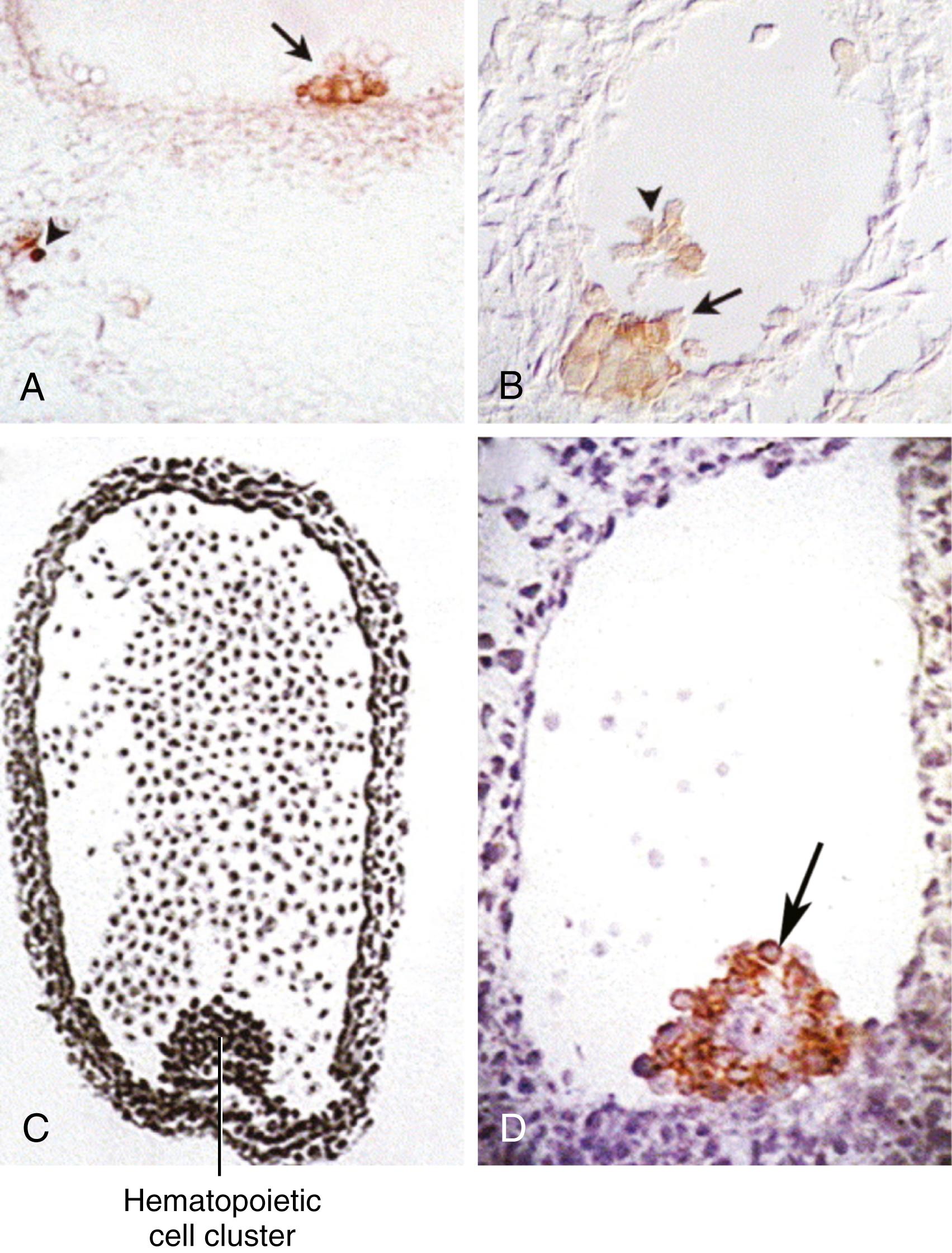
In humans, the liver primordia is colonized first by primitive hematopoietic cells from the yolk sac, possibly as early as day 23 to 24, and then by a second wave containing HSCs from day 30 onward. In vitro assays of human tissue explants of both yolk sac and AGM mesoderm show that both explants can make myeloid cells. However, only the AGM mesodermal tissue gives rise to multipotent hematopoietic cells (that make myeloid and T- and B-lymphocytes). Collectively, these studies suggest the yolk sac extraembryonic mesoderm generates primitive hematopoietic cells necessary for supporting the early cardiovascular needs of the embryo. The definitive HSCs that sustain lifelong adult hematopoiesis are derived from the intraembryonic AGM region (and possibly from hematopoietic clusters in the vitelline and umbilical arteries) and constitute the second wave of cells colonizing the fetal liver before subsequently colonizing the lymphatic organs and bone marrow. The second wave occurs for only a short window of developmental time, ending by day 40 of gestation.
Following the generation of HSCs in the embryo, their survival and proliferation depends on a trophic factor called stem cell factor (Scf, or c-Kit ligand) and its receptor, c-Kit receptor. Mouse mutants completely devoid of the c-Kit receptor or its ligand die in utero of anemia between days 14 and 16 of gestation and contain reduced numbers of erythroid progenitors in the fetal liver. In humans, the C-KIT RECEPTOR protein is expressed in the yolk sac, AGM splanchnic mesoderm, and liver HSCs during all stages of liver hematopoietic development. However, the expression of its ligand, SCF, is temporally regulated. SCF protein is expressed in the AGM region at low levels between days 25 and 34. It is well expressed in human liver by day 34, before levels drop off in late-stage liver development (i.e., by 45 days). Only weak expression of SCF mRNA is detected in the yolk sac (by quantitative real-time polymerase chain reaction; RT-PCR) at 32 days of development. Hence, C-KIT RECEPTOR signaling by SCF in HSCs coincides with the generation of AGM HSCs and with HSC colonization of liver and the appearance of definitive, long-term HSCs. This supports the idea that SCF/c-KIT signaling is involved in survival, differentiation, and proliferation of AGM-derived HSCs in the liver.
flattened endothelial cells and join together to form small vesicular structures. These vesicular structures, in turn, coalesce into long tubes or vessels ( Fig. 13.5 ). This process is referred to as vasculogenesis . These cords develop throughout the intraembryonic mesoderm and coalesce to form a pervasive network of vessels that establishes the initial configuration of the circulatory system of the embryo. This network grows and spreads throughout the embryo by four main processes: (1) continued formation, migration, and coalescence of EPCs; (2) angiogenesis , the budding and sprouting of new vessels from existing endothelial cords; (3) vascular intussusception (non-sprouting angiogenesis), in which existing vessels are split to generate additional vessels; and (4) intercalation of new EPCs into the walls of existing vessels.

Because blood vessels form in the yolk sac on about day 17, but not in the embryonic disc until day 18, it was originally thought that intraembryonic vessels arose mainly because of centripetal extension of the yolk sac vasculature into the embryo proper. However, quail chick transplantation studies provide evidence that almost all of the intraembryonic splanchnic mesoderm has the ability to form blood vessels via vasculogenesis. Furthermore, these experiments show that the characteristic branching pattern of the blood vessels in each region is determined by cues from the underlying endoderm and its extracellular matrix. Although it is clear that the intraembryonic splanchnic mesoderm has the capacity to generate EPCs and to undergo vasculogenesis, the intraembryonic somatic lateral plate mesoderm may not be capable. Studies in avian and zebrafish embryos show that much of this vasculature develops from migrating EPCs derived from the paraxial mesoderm that subsequently forms via vasculogenesis ( Fig. 13.6 ).
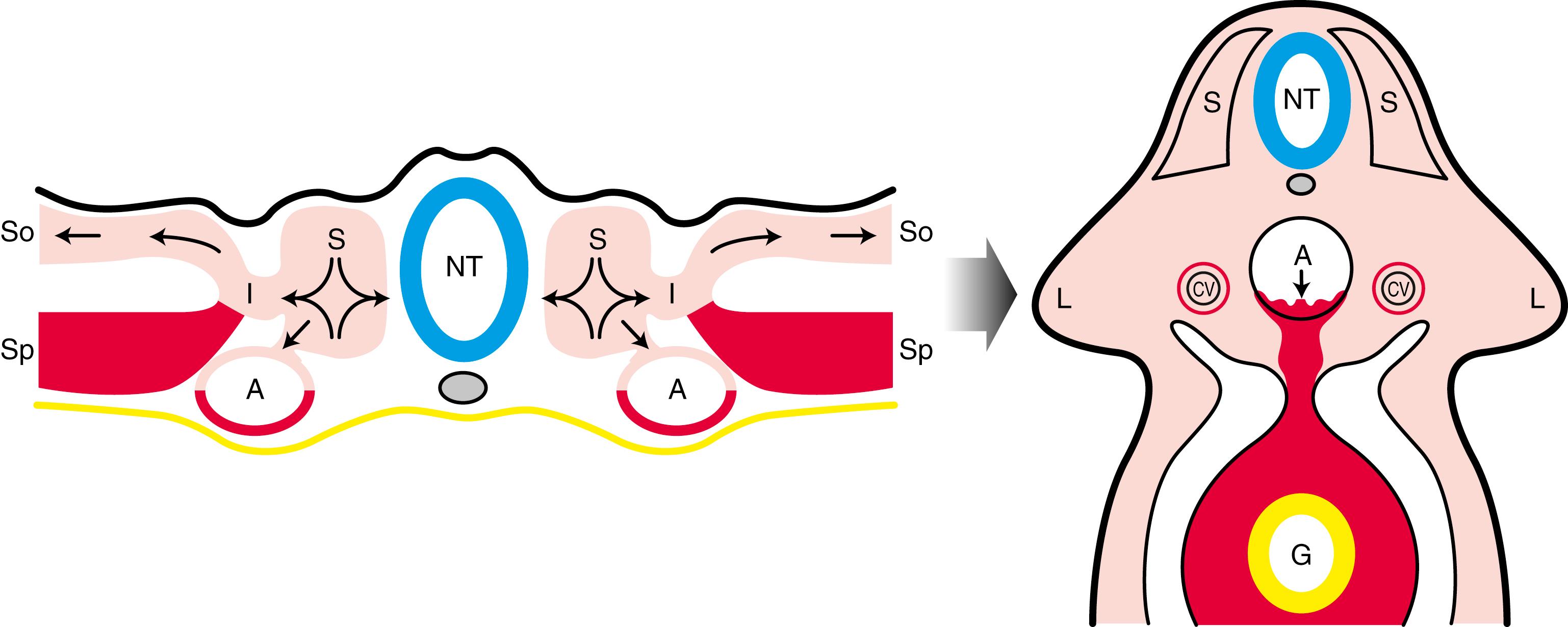
Once a primary vascular plexus is formed in the embryo, it must be remodeled to accommodate growth of the embryo and develop into a system of arteries and veins. Completion and continual remodeling of blood vessels require angiogenesis . Often, the term angiogenesis is inappropriately used interchangeably with vasculogenesis . However, angiogenesis is a different process. Angiogenesis is the expansion and remodeling of the vascular system using existing endothelial cells and vessels generated by vasculogenesis ( Fig. 13.7 ). Expansion by angiogenesis occurs by sprouting or vascular intussusception , a splitting or fusion of existing blood vessels (see Fig. 13.7 ).
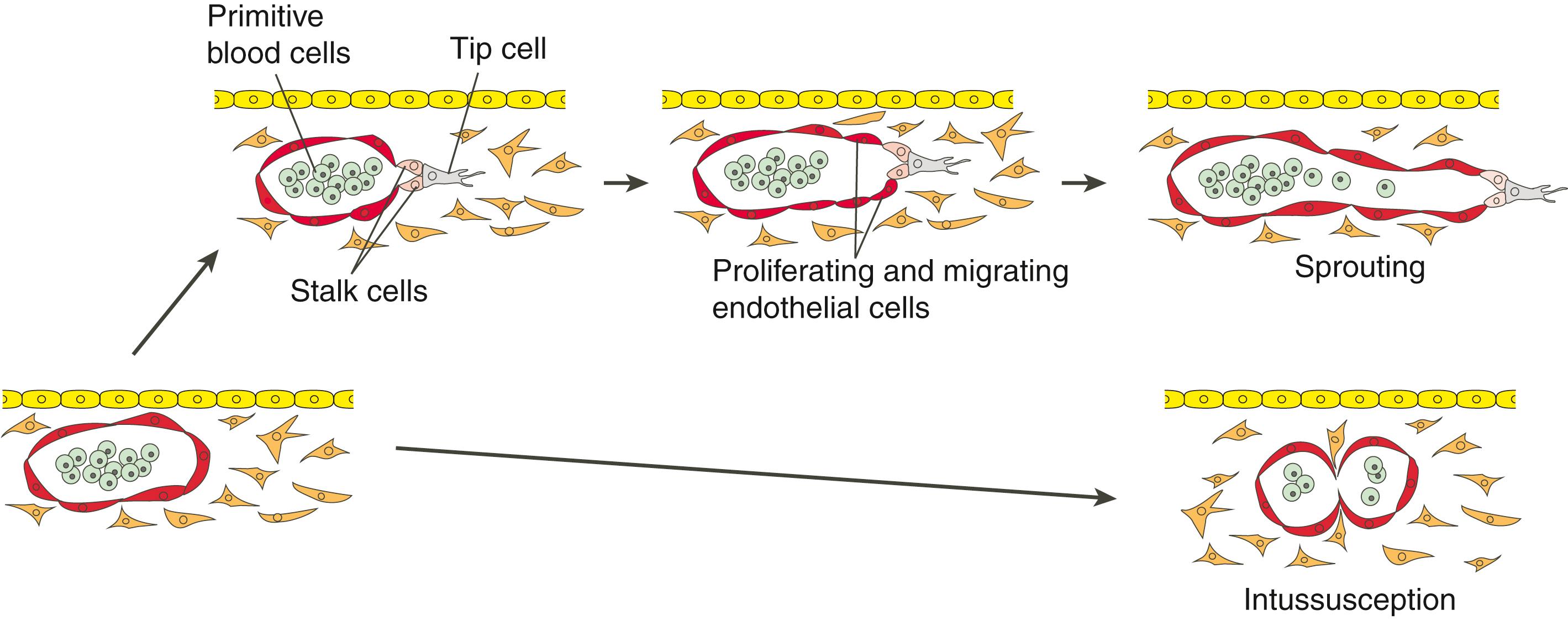
Organization of endothelial cells into recognizable blood vessels usually occurs at the site of EPC specification during vasculogenesis. However, evidence shows that EPCs can also migrate into and proliferate at distant secondary sites before organizing into blood vessels, in a process distinct from angiogenesis (see Fig. 13.6 ). Vessels that form through this modified form of vasculogenesis include (in the avian embryo) the posterior cardinal vein and perineural vascular plexus and (in the Xenopus embryo) the bulk of the dorsal aorta and intersegmental vessels.
It was once thought that EPCs were present only in the embryo and fetus. However, evidence suggests that EPCs exist in adult bone marrow and peripheral blood. Vascular endothelial growth factor (Vegf), granulocyte-monocyte colony-stimulating factor, fibroblast growth factor-2 (Fgf2), and insulin growth factor-1 (Igf1) all stimulate EPC mobilization and differentiation. The decision of circulating endothelial cells to integrate into blood vessel walls is complex and may involve interactions with cytokine and cytokine receptors, binding to denuded endothelial regions, or localizing to areas of platelet aggregates.
As covered in Chapter 12 , in chick embryos, endodermally derived Bmps in the absence of Wnts induce the cardiogenic cell lineage, whereas Bmps in the presence of Wnts enables blood vessel formation in the splanchnic mesoderm. Moreover, Bmp/Tgfβ signals emanating from extraembryonic endoderm and Wnt signaling in mesoderm prime the extraembryonic mesoderm adjacent to the yolk sac endoderm to form blood islands. In mice, visceral endoderm provides inductive signals (e.g., Bmp, Vegf, Indian hedgehog) that are necessary for inducing the expression of blood island markers in this mesoderm. However, the precise trigger for forming hemangioblasts in vivo, and eventually the hematopoietic and EPC lineages, is still unclear. Both hematopoietic precursors and EPCs share many of the same early expression markers, so they are closely tied to one another with regard to cell lineage specification.
What is known is that Vegf signaling through the vascular endothelial growth factor receptor-2 (Vegfr2) is essential. Knockout mice for Vegfr2 have complete absence of hematopoietic progenitors and EPC lineages and die in utero. Moreover, homozygote knockout mice for vascular endothelial growth factor-A (VegfA) die as the result of lack of blood island formation. Mice lacking vascular endothelial growth factor receptor-1 (Vegfr1) also die, but the defect seems to be a consequence of abnormal EPC proliferation resulting in a disorganized vasculature. Vegf is a powerful promoter of vasculogenesis: injecting Vegf into embryos at the outset of vasculogenesis can vascularize normally avascular areas (e.g., cartilage-forming areas and cornea). Hypervascularization is also observed in transient transgenic gain-of-function quail embryos in which Vegf is overexpressed.
One group of transcription factors that seem to play a key role in endothelial cell specification is the Ets protein family. At least 12 different Ets factors are expressed in endothelial cells, with overlapping functions that work in combination to specify the endothelial cell lineage. One, Etv2, seems especially important, as it regulates expression of several early endothelial genes, and mice null for Etv2 lack endothelial cells, exhibit defects in hematopoiesis, and die early in development.
As in vasculogenesis, Vegfs and their receptors play a major role in mediating angiogenesis. In response to VegfA, Vegfr2-expressing endothelial cells, called tip cells , produce long, dynamic filopodia that probe the environment for directional cues (see Fig. 13.7 ). Adjacent endothelial cells called stalk cells proliferate in response to VegfA and express cell adhesion molecules necessary for forming a lumen and maintaining the integrity of the new sprout. So why does the entire endothelium not develop tip cells in response to VegfA? Why do some become stalk cells? The answer involves notch signaling. Notch proteins (notch1–4) are cell-surface receptors for the membrane-bound ligands delta-like 1 (Dll-1), Dll-3, Dll-4, Jag1, and Jag2, which are important in cell fate decision (covered in Chapter 5 ). Mouse embryos deficient in notch1 or notch2 form a normal initial capillary plexus but fail to properly remodel this vasculature. So notch signaling seems to be required for remodeling of the primitive capillary plexus rather than for its initial development.
During angiogenesis, the notch ligand, Dll-4, is predominantly expressed in tip cells, with the strongest notch signaling occurring in the stalk cells. Notch signaling represses sprouting, whereas blocking notch signaling causes excessive tip cell formation. Hence, a tip cell phenotype seems to be the default in the absence of notch signaling, whereas notch signaling promotes the stalk cell phenotype and stabilization of the sprout. In response to VegfA, it is thought that endothelial cells compete via bilateral Dll-4/notch signaling, eventually generating differences between the endothelial cell population of endothelial cells. Those receiving lower levels of notch signaling are specified as tip cells and those receiving higher levels are specified as stalk cells that then downregulate their expression of Vegf receptor (Flt; fms-related tyrosine kinase). As a consequence, these differences in notch signaling alter their subsequent responses to VegfA signaling. This mechanism is consistent with studies showing that mice haploinsufficient for Dll-4 exhibit excessive numbers of tip cells and develop abnormally dense vascular networks.
Xenograph tumor transplant studies in which notch signaling is manipulated also suggest that notch may be an important mediator of tumor vascular patterning by mediating the proper balance in tip and stalk cell numbers. Collectively, these studies show that notch signaling plays a major role in angiogenesis and in remodeling of the primitive capillary plexus by mainly acting as a negative regulator of sprouting.
The stalk-cell phenotype is also actively suppressed, allowing tip formation, by neuropilin-1, a co-receptor for Vegf, and semaphorins, which establishes differential responses to Tgfβ and Bmp signaling in these cells. The Tgfβ family and Tgfβ receptor signaling components—Alk1, Alk5, and endoglin—play critical roles in vasculogenesis and angiogenesis. Knockout mice for the Tgfβ receptors, Alk1 and Alk5, and the Tgfβ-binding protein, endoglin, are defective in angiogenic remodeling as a result of impaired endothelial cell migration and proliferation. They develop abnormal arterial-venous connections, much like those discussed in the “Clinical Taster” for this chapter. Moreover, recruitment of vascular smooth muscle is deficient, leading to poor vascular integrity and vascular instability. Tgfβ exhibits both stimulatory and inhibitory effects on endothelial cells. Recent studies suggest that the decision as to whether to continue angiogenesis or mature into a vessel depends on an interplay between the stimulatory effect of Tgfβ/Alk1 signaling (promoted by endoglin) and the inhibitory effect of Tgfβ/Alk5 signaling.
Another group of receptors and ligands that act in parallel to promote proper angiogenesis are the Tie (tyrosine kinase with immunoglobulin-like and Egf-like domains) receptor/angiopoietin group. Angiopoietin-1 (Ang1) and tyrosine kinase with immunoglobulin-like and Egf-like domains-2 (Tie2) are clearly involved in regulating intussusception of the vasculature, whereas Ang2, in cooperation with the stimulatory effects of Vegf, stimulates sprouting. Mice lacking the Tie2 gene or its ligand Ang1 develop abnormally large and leaky vessels and die in utero. Moreover, these mice exhibit a decrease in endothelial cell number and angiogenic sprouting, as well as failure of vascular intussusception. Tie1 knockout mice develop vessels with holes, and the endothelial cells appear necrotic. These results show collectively that Tie/Ang signaling along with Vegf signaling is essential for expansion and normal remodeling of blood vessels after the initial primitive vasculature is established.
One of the main driving forces for vascularization by angiogenesis is the need to counteract hypoxia. Low oxygen saturation leads to stabilization of the transcription factor, hypoxia-inducible factor-1α (Hif1α). Hif1α upregulates VegfA expression and nitric oxide synthase expression. Nitric oxide production dilates existing blood vessels, thereby increasing the permeability and extravasation of plasma proteins, leading to an increase in expression and activation of the proteases, matrix metalloproteinases, and plasmin. Matrix metalloproteinases and plasmin play major roles in promoting proliferation and migration of endothelial cells by activating growth factors and receptors and increasing extracellular matrix turnover, which is necessary for sprouting. Proper vascular development also involves trimming away vessels that are no longer necessary or that would be detrimental should they remain. For example, in its early development, the retina initially forms excess vascularity that must be trimmed down later. Experimental hyperoxia (i.e., surplus oxygen) in rodents suppresses Vegf levels in the retina. Because Vegf acts as a survival factor for retinal endothelial cells, hyperoxia resulting from the excess blood supply may drive the pruning of excess vessels by decreasing Vegf levels ( Fig. 13.8 ). Hence, the degree of vascularity (i.e., driven by the formation or pruning of vessels) of a tissue may be mediated by oxygen-dependent regulation of Vegf and nitric oxide levels. Finally, mechanical forces associated with luminal and transmural blood flow and endothelial cell metabolism are increasingly being recognized as regulators of sprouting and branching.
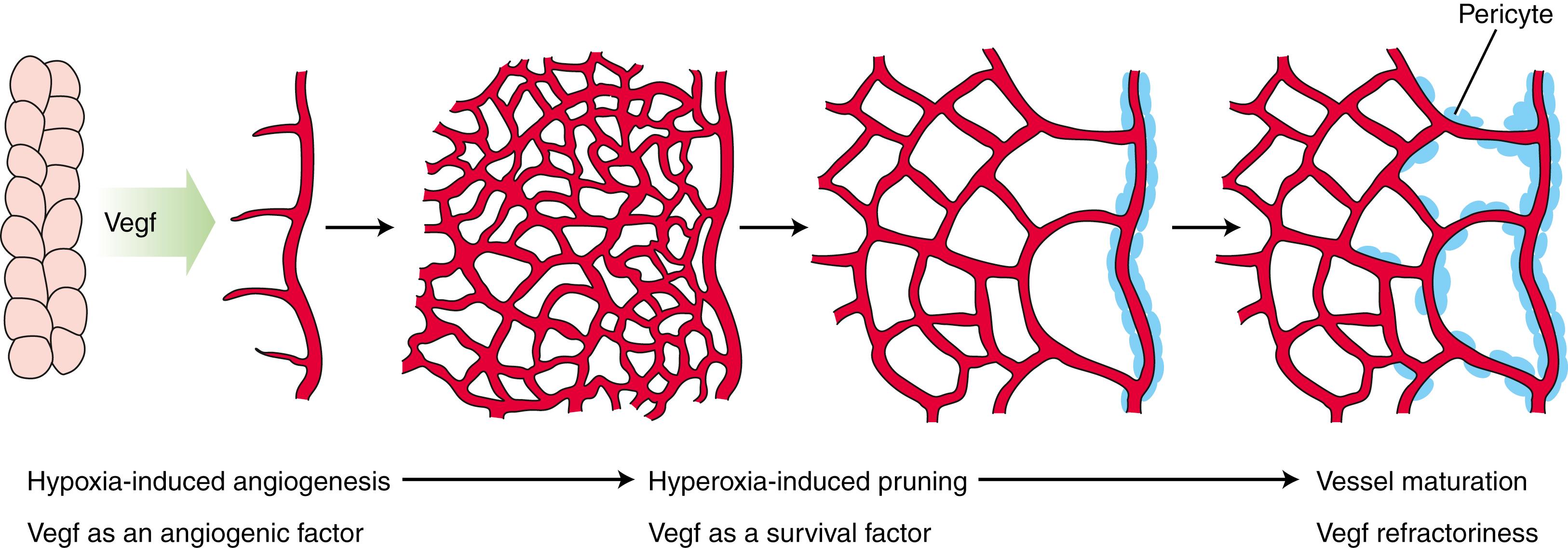
Arteries and veins are terms used to describe vessels whose direction of blood flow is either away from heart (artery) or toward the heart (vein). In addition to these differences in direction of blood flow, arteries and veins are very different in their morphology and physiology. So how does a network of interconnecting vessels become designated as one type or the other? Flow dynamics and the physiological requirements for various loads placed on the vessels are some of the considerations thought to drive arterial or venous specification. Based on studies in the chick embryo, where visualization and ready access to the extraembryonic vasculature are possible, it seems that as perfusion of some capillary-sized vessels increases (arterial side), some downstream side branches are disconnected. These disconnected vessels are then remodeled to establish a second, parallel vasculature that connects to vessels leading to the venous pole of the developing heart. Once this occurs, the connection to the arterial side is reestablished. Recent studies suggest that endothelial cells in these capillary beds are not all identical; rather, some acquire an arterial or venous specification even before blood flow ensues (covered later). However, studies also suggest that endothelial cells remain somewhat plastic in their ability to integrate into arterial or venous endothelium based on cues present in their local environment.
The factors that direct and guide vessel remodeling and identity are still unclear, but several ligands and receptors known to play roles in neuronal guidance (covered in Chapter 10, Chapter 9 ) seem to be involved in this process. One such group includes the Eph receptors and their membrane-bound ligands, the ephrins. The binding of ephrins to EphB receptors stimulates transduction signals in the EphB-expressing cells, but this binding can also transduce a reverse signal into the ephrin-expressing cell. Such interactions and signaling events play important roles not only in the development of the nervous system but also in blood vessel remodeling and in the specification of the artery or vein phenotype. EphrinB2 is specifically expressed on the surface of arterial endothelial cells, whereas the EphB4 receptor is specifically expressed on venous endothelial cells ( Fig 13.9 ). When either ephrinB2 or EphB4 is knocked out in mice, the remodeling of primary vascular plexus into arteries and veins fails. How ephrinB2 and EphB4 mediate these changes is unclear, but it has been suggested that during angiogenesis, differential expression of these two molecules may restrain cell migration and create tissue boundaries used to sort out the arterial and venous systems. What is responsible for mediating specific expression of ephrins and Eph receptors is unclear but may involve Tgfβ-mediated signaling, as ephrinB2 expression is absent in Alk1-deficient mice.
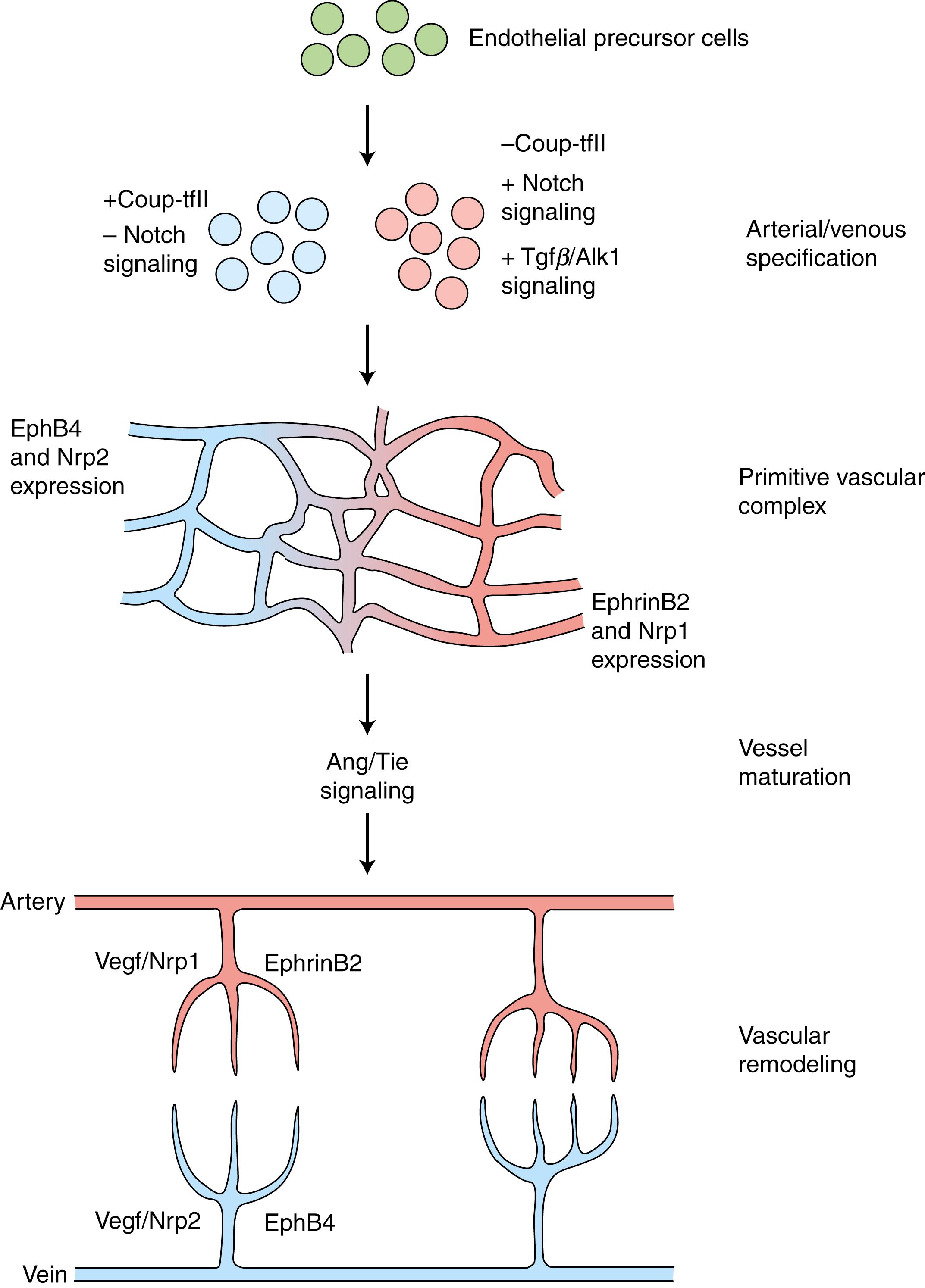
Notch signaling may also play a key role in establishing arterial or venous identity upstream of ephrins/Eph receptor signaling even before the formation of the initial vascular complex (see Fig. 13.9 ). In mice, notch1, notch3, and notch4 receptors and their ligands, Dll-4, Jag1, and Jag2, are expressed in arteries but not in veins. Studies in zebrafish show that inhibiting the notch signaling pathway decreases the expression of ephrinB2, resulting in the ectopic expression of venous markers in the dorsal aorta. In contrast, increasing notch signaling decreases the expression of venous markers and induces the expression of arterial markers, including ephrinB2. In mice, expression of the venous transcription factor chicken ovalbumin upstream promoter transcription factor 2 (Coup-tfII) (also known as Nr2f2) actively represses notch signaling and the expression of the arterial marker neuropilin-1 (Nrp1) and promotes the expression of the venous marker Nrp2. Loss of Coup-tfII expression in veins promotes the expression of the arterial marker, Nrp1. Both Nrp1 and Nrp2 are co-receptors for Vegf that bind specific splice variants of Vegf and may mediate differential responses to Vegf signaling in endothelial cells. Therefore, notch signaling may have an important role in mediating not only vascular angiogenesis and remodeling but also arterial/venous specification of EPCs (see Fig. 13.9 ). Finally, notch signal plays an important role in mediating the diameter of developing blood vessels.
Several other ligands and receptors known to play roles in neuronal guidance are involved in guiding arterial and venous blood vessel formation and remodeling, including slit/robo, semaphorins/plexins, and netrins/Unc5b. This may not be too surprising given that vessels and peripheral nerves generally run in parallel with one another.
Blood and lymphatic vessels are stimulated by angiogenic factors to grow into developing organs. If vessel growth is not inhibited at the appropriate time, or if it is stimulated again later in life, blood or lymphatic vessels may proliferate until they form a tangled mass that may have clinical consequences. Excessive growth of small capillary networks is called a capillary hemangioma or nevus vascularis ; a proliferation of larger venous sinuses is called a cavernous hemangioma. Hemangioma of infancy is the most common benign tumor of childhood (incidence of about 2.5% in neonates and up to 10% to 12% in 1-year-olds; Fig. 13.10 ). These tumors grow rapidly and consist mainly of endothelial cells with or without lumens, multilayered basement membranes, and fibrous tissue. Hemangiomas differ from some vascular anomalies like nevus flammeus , which present at birth as birthmarks and grow proportionately with the growth of the child. Most cases of hemangioma of infancy pose no immediate or long-term danger. However, they can be potentially life threatening if they grow in vital organs (e.g., in the skull or vertebral canal, where they can lead to nervous system dysfunction, or in airways, where they can obstruct breathing) or are large enough to create a shunt of physiological significance leading to heart failure. In rare cases, a hemangiosarcoma (metastatic angioma) can develop.
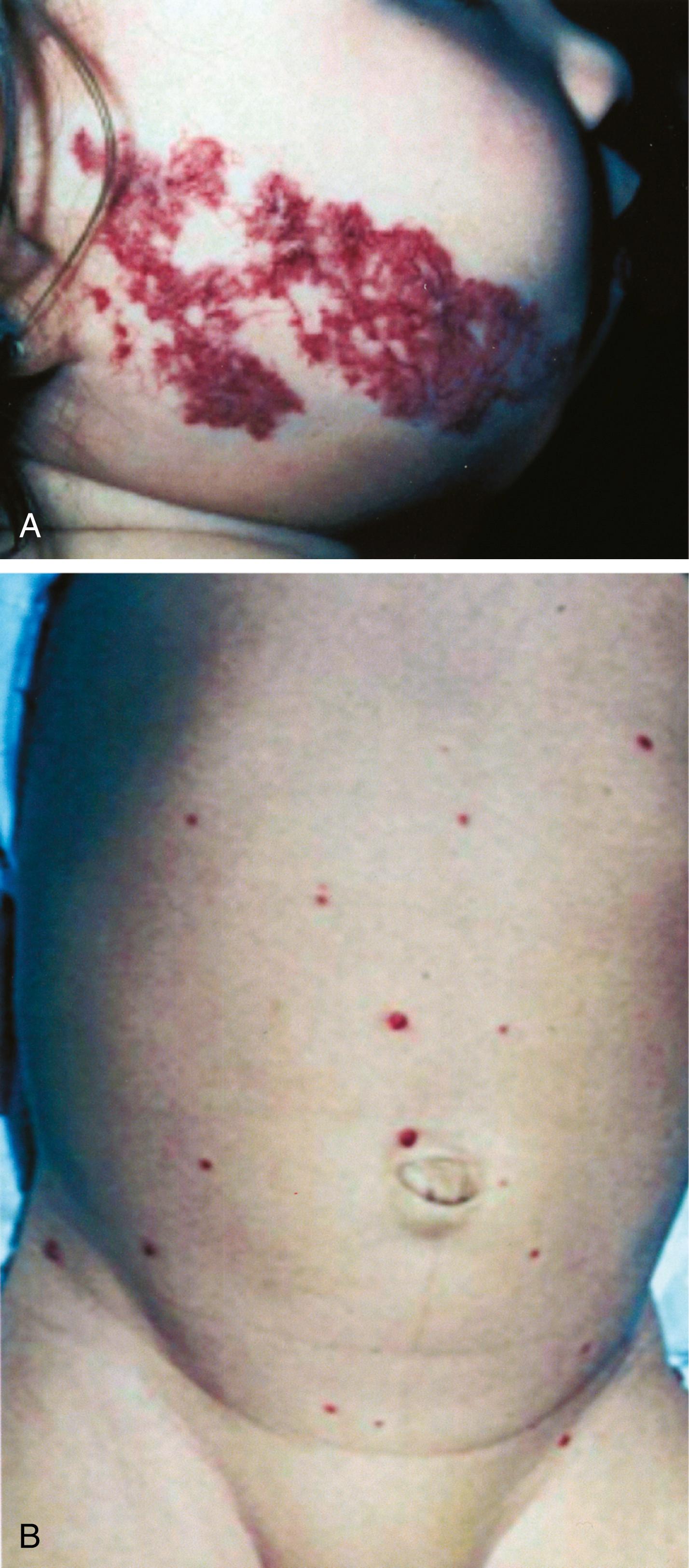
Many hemangiomas seem to have a genetic basis to their origin, as they are associated with developmental syndromes resulting from chromosomal anomalies. In the case of hemangioma of infancy, some cases are linked to chromosome region 5q31-33. This region contains genes coding for Fgf4, Pdgfβ, and fms-related tyrosine kinase—molecules important in blood vessel development. Some hemangiomas are also linked to dysregulation of the Tie/Ang signaling pathway and to FLT2 (VEGFR2) mutations. Multiple hemangioblastomas are associated with a rare, dominantly inherited, familial cancer syndrome called von Hippel-Lindau disease (incidence 1:36,000) characterized by mutations in a tumor suppressor gene located at chromosome 3p25-26. These individuals exhibit life-threatening multiple central nervous system, retinal, and liver hemangioblastomas, renal cell carcinomas, and visceral cysts. Studies show that stromal cells of these tumors produce high levels of Vegf and Hif1α, which could account for the excessive angiogenesis.
Mutations in ALK1 and ENDOGLIN have been linked to hereditary hemorrhagic telangiectasia (HHT). The most common manifestations of HHT (prevalence 1:5000 to 1:8000) are nosebleeds and small vascular anomalies called telangiectases; however, gastrointestinal bleeding and arterial-venous malformations in the lung, brain, and liver progressively develop. Mice heterozygous for mutations in Alk1 or endoglin exhibit very similar progressive pathologies, including the development of large arterial-venous shunts. Mutations in human ALK1 have also been linked to primary pulmonary hypertension involving abnormal remodeling of the pulmonary vasculature. Both HHT and some forms of pulmonary hypertension may stem from an improper balance between Alk1 and Alk5 signaling (covered earlier in the chapter). Endothelial cells from normal healthy patients form extensive, stable, and well-formed vessels in tissue culture, whereas endothelial cells from HHT patients are unable to do so. Endoglin also interacts with the actin cytoskeleton. Endothelial cells from HHT patients exhibit a disorganized actin cytoskeleton, but normal actin organization can be restored if normal Endoglin is overexpressed in these cells. Endothelial cells with a disorganized, abnormal cytoskeleton are more likely to form vessels prone to vascular instability, hemorrhaging, and vascular disarray.
![]()
Animations are available online at StudentConsult .
The respiratory apparatus of the jawless fish that gave rise to higher vertebrates consisted of a variable number of gill bars separated by gill slits ( Fig. 13.11 ). Water flowed in through the mouth and out through the gill slits. Each of the gill bars, or branchial arches , was vascularized by an aortic arch artery , which arose as a branch of the dorsal and ventral aortae. Gas exchange took place in the gill capillaries, and the dorsal half of each aortic arch artery conveyed the oxygenated blood to the paired dorsal aortae.
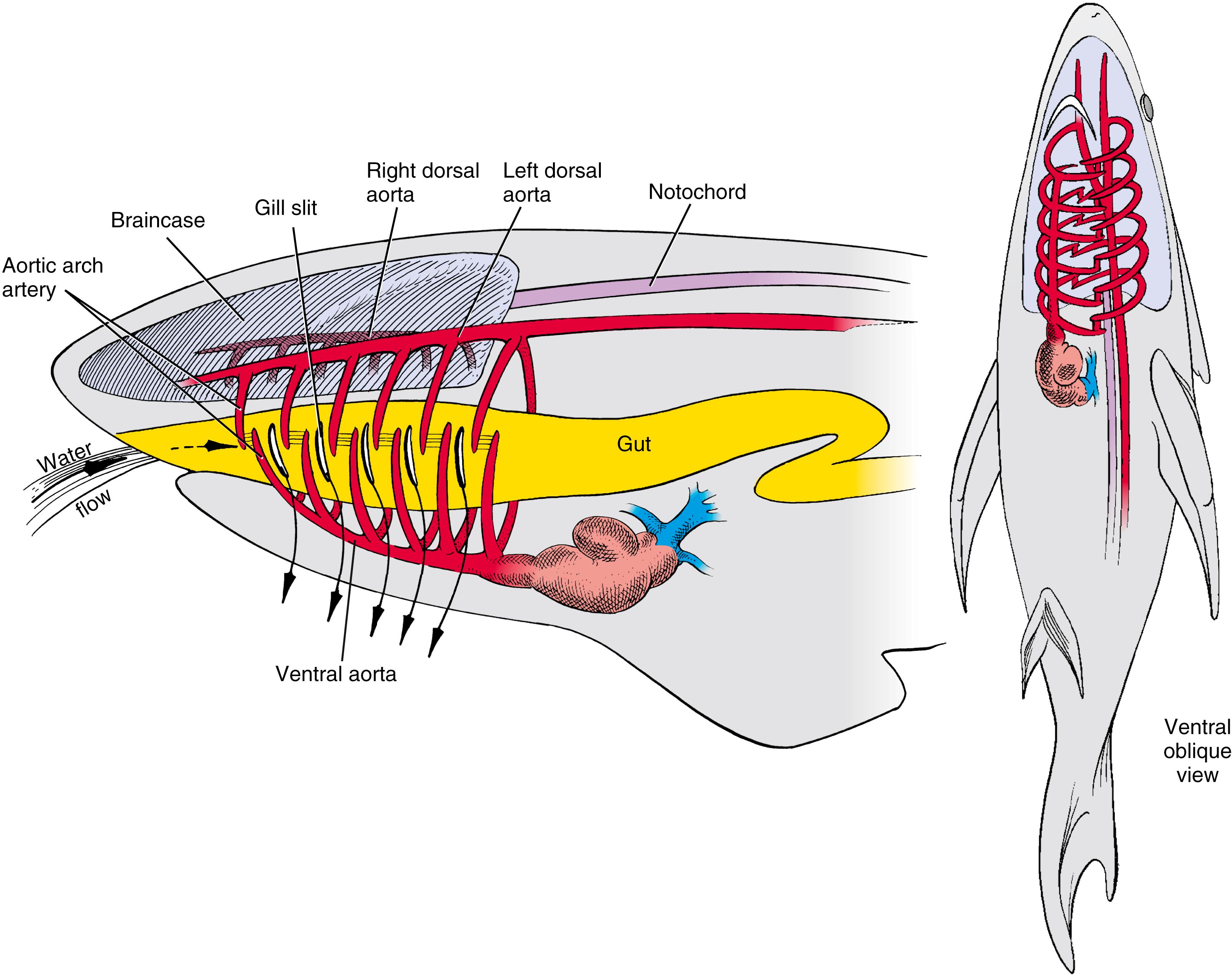
In embryos of higher vertebrates including humans, four pairs of mesenchymal condensations develop on either side of the pharynx, corresponding to branchial arches one, two, three, and four. These arches are separated by ectodermal clefts and endodermal pouches. A more caudal arch forms that in most textbooks is referred to as a sixth arch, explaining that the numbering reflects a transient branchial arch and a desire to align it homologically with the caudal-most (terminal) arch seen in amphibians. However, recent morphologic studies in amniotes, including humans, has found no evidence for a transient fifth branchial arch or fifth pouch. Moreover, markers for the caudal-most branchial pouches are expressed in the fourth pouch of amniotes, supporting the absence of a sixth branchial arch in amniotes. Hence in keeping with the numbering found in other vertebrates, the arches in humans should be denoted as arches 1 through 5 rather than 1 through 4 and 6. We have adopted the revised numbering in this text.
The mesodermal, ectodermal, and endodermal components of the arches have been modified through evolution, so that in humans they form the structures of the lower face and neck and derivatives of the pharyngeal foregut. Thus, these structures are more appropriately called pharyngeal arches rather than branchial arches. Hence in this chapter and in Chapter 12, Chapter 17 , the caudal-most arch will be referred to as the fifth pharyngeal arch rather than as the sixth pharyngeal arch. Development of the pharyngeal arches is detailed in Chapter 17 ; the following text is limited to development of the aortic arch arteries.
Become a Clinical Tree membership for Full access and enjoy Unlimited articles
If you are a member. Log in here